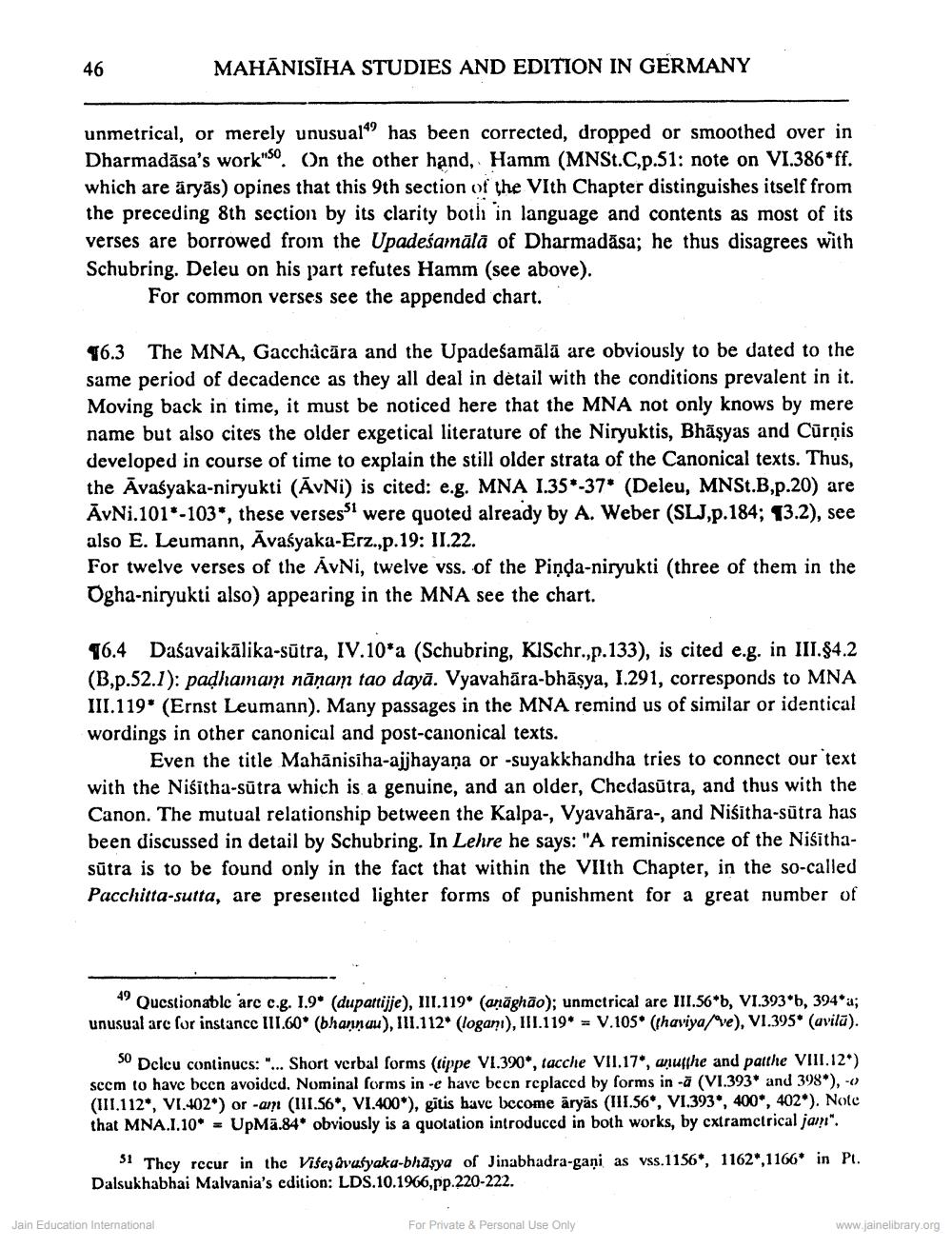________________
46
MAHĀNISĪHA STUDIES AND EDITION IN GERMANY
unmetrical, or merely unusual" has been corrected, dropped or smoothed over in Dharmadāsa's work"SO. On the other hand, Hamm (MNSt.C.p.51: note on VI.386*ff. which are äryās) opines that this 9th section of the Vith Chapter distinguishes itself from the preceding 8th section by its clarity both in language and contents as most of its verses are borrowed from the Upadeśamālā of Dharmadása; he thus disagrees with Schubring. Deleu on his part refutes Hamm (see above).
For common verses see the appended chart.
16.3 The MNA, Gacchåcāra and the Upadeśamālā are obviously to be dated to the same period of decadence as they all deal in detail with the conditions prevalent in it. Moving back in time, it must be noticed here that the MNA not only knows by mere name but also cites the older exgetical literature of the Niryuktis, Bhāşyas and Cūrnis developed in course of time to explain the still older strata of the Canonical texts. Thus, the Avaśyaka-niryukti (ĀvNi) is cited: e.g. MNA 1.35*-37* (Deleu, MNSt.B,p.20) are ĀvNi.101*-103*, these verses were quoted already by A. Weber (SLJ,p.184; 13.2), see also E. Leumann, Avaśyaka-Erz.,p.19: II.22. For twelve verses of the AvNi, twelve vss. of the Pinda-niryukti (three of them in the Ogha-niryukti also appearing in the MNA see the chart.
96.4 Daśavaikālika-sūtra, IV.10*a (Schubring, KISchr.,p.133), is cited e.g. in III.$4.2 (B,p.52.1): padhamam nāņam tao dayā. Vyavahāra-bhāșya, 1.291, corresponds to MNA III.119' (Ernst Leumann). Many passages in the MNA remind us of similar or identical wordings in other canonical and post-canonical texts.
Even the title Mahānisiha-aijhayana or -suyakkhandha tries to connect our text with the Niśitha-sūtra which is a genuine, and an older, Chedasūtra, and thus with the Canon. The mutual relationship between the Kalpa-, Vyavahāra-, and Niśitha-sūtra has been discussed in detail by Schubring. In Lehre he says: "A reminiscence of the Nišithasūtra is to be found only in the fact that within the VIlth Chapter, in the so-called Pacchitta-sutta, are presented lighter forms of punishment for a great number of
" Questionable arc c.g. 1.9* (dupattijje), III.119* (anāghão); unmctrical are III.56*b, VI.393*b, 394a; unusual arc for instance I11.60* (bhannau), 111.112* (loganı), 111.119* = V. 105* (thaviya/ve), VI.395* (avilā).
30 Dclcu continues: "... Short verbal forms (tirpe VI.390*, tacche VII.17*, auffhe and parthe VIII.12*) sccm to have been avoided. Nominal forms in -e have been replaced by forms in -a (V1.393* and 398*), --> (111.112*, VI.402) or -am (111.56*, VI.400*), gitis have become āryās (111.56*, VI.393, 400", 402*). Note that MNA.1.10* = UpMā.84* obviously is a quotation introduced in both works, by cxtramctrical janrı".
31 They rccur in the Vises avusyaka-bhasya of Jinabhadra-gani as vss.1156, 1162*,1166* in Pt. Dalsukhabhai Malvania's edition: LDS.10.1966, pp.220-222.
Jain Education International
For Private & Personal Use Only
www.jainelibrary.org




